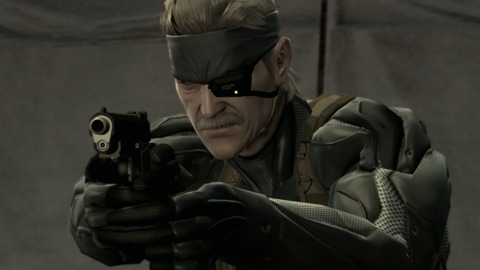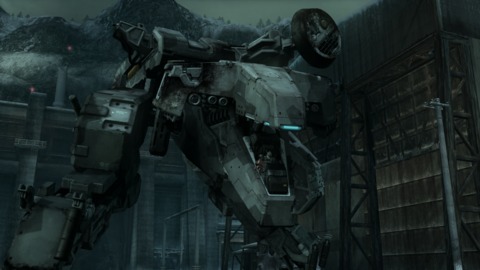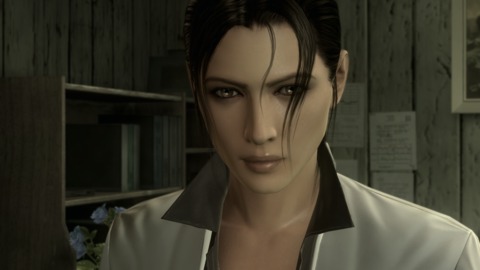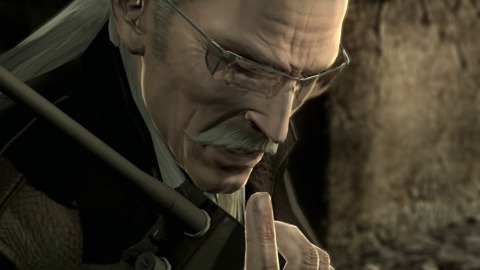Metal Gear Solid 4: Guns of the Patriots Review
Metal Gear Solid 4 is a fitting coda to the series and the single best reason to own a PS3 so far.
Metal Gear Solid 4: Guns of the Patriots is an incredible experience, the best game yet for the PlayStation 3 and a must-see finale to Hideo Kojima’s seminal, often celebrated (and occasionally reviled) stealth action series. But there’s a surprising degree of irony in the success of this last game, which is at its best in ways its predecessors conspicuously fell flat. If you haven’t played a lot of Metal Gear Solid before now, I’m talking about the gameplay here–the part where you grasp a controller and actively make Solid Snake creep around the shadows, stealthily snapping necks and infiltrating enemy bases to stop some nefarious plot or other.

Given that legacy, what a surprise it was to discover that Guns of the Patriots is not just the most playable game in this franchise but possibly the most graphically intensive and downright thrilling action game ever made. It’s the first game in the series to periodically remove your stealth shackles and actually suggest you plow through your obstacles with guns ablaze, and it does this with seriously explosive aplomb. There are sequences here that come close to fulfilling the promises of Sony’s famously overblown Killzone 2 trailer, in terms of their visual fidelity and the intensity of the action. I honestly had to remind myself more than once I was playing a video game and not a CG movie. If you’re playing this on an HDTV and home theater system, they’ll get a major workout.

Some of the new stealth toys–like the background-mimicking OctoCamo or your little robotic operating buddy the Metal Gear Mk. II–make the sneaking that much more fun to tackle. Then there’s the arsenal of weapons, which has to be the biggest, or at least the most extensible, yet in the series. It’s not enough that you can collect a mountain of assault rifles, submachine guns, pistols, and explosives–you can also slap on laser sights, flashlights, scopes, fore grips, and under-mounted grenade launchers and shotguns. It’s easy to get sucked into the weapons customization, which comes courtesy of a smooth-talking gun dealer named Drebin (who figures into the storyline too).
As nice as this mammoth arsenal is, it’s even nicer that the game actually encourages you to use all those guns. You can meticulously sneak your way through every scenario if you want, and in fact, there are specific rewards for killing few or no enemies. But in many areas a run-and-gun approach is equally viable and will often let you ally yourself with local militia fighting against Liquid Ocelot’s ubiquitous, nanomachine forces.

Plot-wise, the game breaks from tradition in a couple of important ways. For one, it’s not afraid to move the story ahead in time and geography, so you get multiple discrete acts that take place in far-flung locations around the globe. One of these acts offers a great dose of nostalgia for longtime series vets, though discovering what that act is all about is one of the greatest joys in playing the game. The other is the sweeping closure that results from the full disclosure of the series’ many secrets that occurs by the end of the game. If you’ve been wondering about the eventual fates of characters like Raiden, Eva, Vamp, Naomi Hunter, Meryl Silverburgh, and the rapidly aging Snake himself–not to mention the truth about the FoxDie virus, the shadowy Patriots, and the legacy of Big Boss–you’ll get them all gift-wrapped on a platter by the close of the game.
Anyone who’s played the previous Metal Gear Solid games will already know that to fully appreciate Guns of the Patriots, you must come to grips with Kojima’s unique brand of narrative outlandishness. The cutscenes here are no less frequent, lengthy, or indulgent than before; they’re rife with over-the-top, implausible plot twists, drawn-out exchanges of occasionally stilted dialogue, and character models who, for all their extreme realism, descend into that uncanny valley from time to time. But these scenes excite far more often than they drag. The game is also peppered liberally with Kojima’s trademark little post-modern touches, like references to you the player and the PlayStation 3 hardware, and a smart, quick flashback sequence toward the end that will be especially satisfying for series vets.

You could level some other minor complaints at Guns of the Patriots. The game stops to load a little too frequently, and it features not only an initial eight-minute install process but also several subsequent, shorter ones before each act. But none of the game’s minor blemishes are enough to detract from its massive overall impact. It’s the surprising entertainment value of the action, the mind-blowing visuals, and the completeness of the story’s conclusion that make this last installment so satisfying. Metal Gear Solid 4’s positive qualities make it one of the most significant game releases of this generation, and anyone with an appreciation for the evolving form of the medium would do well to play it from start to finish.
